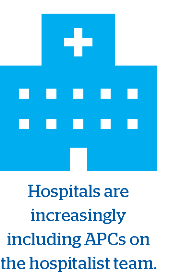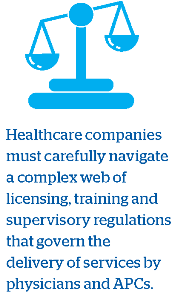America faces a looming primary care physician shortage.
How bad is it? A study funded by the Association of American Medical Colleges notes that by 2020 there will be a shortage of 91,500 physicians.1 Many physicians are scaling back the numbers of new patients or limiting the services provided to underserved populations, namely poor urban communities and rural populations where residents have no or limited access to healthcare clinics. Approximately 10 percent of America’s physicians have rural practices even though one-fourth of the population lives in these areas.2 Further increasing the nationwide strain on the supply of physicians, the Affordable Care Act (ACA) could result in 15 million more Medicare-eligible Americans and more than 30 million Americans overall participating in the healthcare system by 2025.3
The physician shortage raises the risk for patient harm. In a 2012 study by the Physicians Foundation, physicians reported they were "at capacity" and were "overworked and over extended."4 Physicians remaining in the marketplace face multiple liability challenges posed by errors due to exhaustion, longer patient wait times, the inability to quickly address worsening medical conditions, and the lack of time to provide preventative medical care.
One solution: increased use of APCs. But there are risks.
Increased use of advanced practice clinicians (APCs), including physician assistants (PAs) and nurse practitioners (NPs), has been one solution to the shortage of physicians. In some rural areas, APCs are the only healthcare professionals available for miles. For example, in 2011 South Dakota had 757 licensed primary care physicians, but 19 counties where there was no primary care physician at all.5 APCs are also playing a critical role in modern healthcare team-based delivery systems designed to improve cost-effectiveness.

While the increased use of APCs offers many benefits, it also brings professional liability concerns.6 Healthcare companies must carefully navigate a complex web of licensing, training and supervisory regulations that govern the delivery of services by physicians and APCs. Moreover, these regulations vary by state and change frequently due to the ongoing debate between industry stakeholders about the role of physicians versus APCs. To mitigate the risk of litigation, healthcare entities need to have robust compliance practices and a comprehensive insurance program in place. Working with both a broker and insurance carrier that understand all the nuances and exposures of healthcare liability can help on both fronts. An experienced and knowledgeable broker and carrier will not only be able to provide customized coverage to address the healthcare company's needs but also recommend best practices to reduce healthcare liability risks.
Defining the Advanced Practice Clinician
The role of APCs has evolved since the 1980s in response to increasing primary healthcare needs. NPs practice under their own licensure and can practice independently in some venues. PAs practice medicine only under the direction of a licensed physician. Both professions require a master's level degree and both professions require passage of a state-licensing exam. APCs are growing in number and make up close to 20 percent of today’s healthcare workforce.
Many APC practices are trending toward specialization such as neonatology, cardiovascular and palliative care among others. By specializing, APCs avoid the long hours and lower pay typical for primary care positions. However, such specialization places APCs in high risk treatment environments, a consideration when evaluating professional liability exposure.
APC licensure laws are unique to each state and require a minimum level of competency to protect the public health. These laws specify minimum standards of education as well as who may prescribe medications in any given state. Most of these statutes and regulations are the result of long fought compromises among the medical professional groups and APC and have been crafted in increments over decades. These factors contribute to the great disparity in the laws governing APCs from state to state. Healthcare entities that employ APCs should make sure the carriers underwriting their liability coverage fully understand the statutes and restrictions in each state.
Advanced Practice Clinician Scope of Practice
As APC regulation has evolved and broadened over the past two decades, the scope of practice for APCs has also expanded from providing only basic and preventative medical care to include medical tasks previously restricted to physicians, like prescribing certain medications, performing minor surgery and assisting in major surgery. Statutes governing APC licensure and scope of practice are unique and state specific. Most state laws limit the APC scope of practice to mirror the supervising physician's scope of practice.
Healthcare entities often do not utilize APCs to their maximum ability for fear that technical violations of state licensing laws could expose them to malpractice. Terms such as 'independent,' 'collaboration,' and 'supervision' are used most widely in state regulation, but their interpretations vary.7 What is described as 'supervision' in one state may, in practice, be more like the definition of 'collaboration' in another state.
All state laws define prescribing as an element of the practice of medicine. Comprehensive knowledge of pharmacology in unison with the ability to make an appropriate diagnosis is crucial to prescribing competently. PAs have "full prescriptive authority" in 42 states and in the District of Columbia, meaning the supervising physician will determine what drugs a PA can prescribe.8 NPs are allowed to prescribe drugs in 42 states and the District of Columbia but in half of these states, the NP must be under the supervision of a physician.9 Regardless of their legal authority, some APCs are routinely writing and obtaining prescriptions for their patients. They do so by phoning pharmacies under a physician's name or using a prescription pad, pre-signed by the physician who supervises them.10 These methods are of questionable legality and spotlight an area of liability exposure for the APC, as well as their supervising physician and/or employer.
Liability Issues
As the APC profession matures, healthcare stakeholders must increasingly focus on professional liability associated with an independent practice. Research based on the National Practitioner Data Bank reflects the liability risk for APCs is less than that of physicians in terms of malpractice payments and number of citations. One study concluded that APCs were 12 times less likely to make a malpractice payment than physicians from 1991-2007.11 This data may reflect that legal actions more often target physicians who treat higher risk patients. Conversely, APC advocates argue that APCs are sued less frequently because they provide more individualized care which has been shown to reduce the likelihood of a patient filing suit against a provider. Thus, APC advocates note employing APCs may reduce physician malpractice suits. The expanding scope of practice for all APCs highlights the importance of reviewing this data periodically. Healthcare entities need to consider that physicians, supervisors and employers may be held accountable for the actions of an APC. While the risk of being sued may not increase when APCs are part of a physician practice, physicians may still be exposed if a patient is harmed by a treating APC, even if the physician is not directly involved in the patient's care.12

A case in point involved the alleged misdiagnosis of a stroke or cerebrovascular accident (CVA) by an APC in a Florida emergency department. The APC erroneously diagnosed a 44 year old male  with sinusitis, when presented with classic stroke symptoms.13 Both the APC, the supervising physician and the medical facility were named in the lawsuit. Although the supervising physician reviewed CT scans, he relied on the APCs physical examination and neurologic assessment. The supervising physician did not examine
with sinusitis, when presented with classic stroke symptoms.13 Both the APC, the supervising physician and the medical facility were named in the lawsuit. Although the supervising physician reviewed CT scans, he relied on the APCs physical examination and neurologic assessment. The supervising physician did not examine
the patient himself, but prescribed a pain reliever and ordered the patient to be discharged. The patient later suffered a stroke, and subsequent paraplegia. During the trial, it came to light that the APC had not passed his licensing exam, thus the physician and the medical facility were both facing exposure for failure to supervise the APC and confirm his credentials. The jury award was $217 million. This case underlines the need for careful evaluation of protocols and state requirements when insurers are considering a policy involving APCs.
Collaborative Agreements
Most states require written collaboration agreements between an APC and a licensed supervising physician. Collaborative agreements are written agreements between an APC and a licensed physician that delineate the responsibilities and expectations of both parties, as well as define specific services an APC may provide at the discretion of the supervising physician. Some states refer to these agreements as "Standard Care Arrangements." Supervising physicians bear the responsibility of ensuring complicated tests are not delegated to unprepared APCs. In states where collaborative agreements are required, the supervising physician has a duty to report APCs who fail to comply with the agreements to state and federal regulatory boards. Collaboration agreements essentially set up an agency relationship between the APC and physician, leading to increased liability exposure for supervising physicians and medical facilities.
Delivery of Care
Hospitals are increasingly including APCs on the hospitalist team. In 2012, the State of Hospital Medicine reported that half of hospitalist medical teams use APCs.14 APCs are involved in coordinating admissions, taking histories, performing exams, and placing central lines. While licensing requirements and supervision regulations vary in each state, literature supports excellent quality of care outcomes when APCs are utilized in the hospital environment.

APCs provide affordable healthcare at designated clinics within retail stores, such as Walgreens or Target. Approximately 30 percent of patients who visit a retail clinic do not have a primary care doctor, and another thirty percent are uninsured.15 APCs that staff retail medical clinics generally have a referral system in place with a local or supervising physician. Retail medical clinics take the pressure off local emergency departments as APCs can treat uninsured patients for their primary care needs rather than the uninsured draining the resources of the local emergency department for non-emergent care. As the popularity of retail clinics continues to rise, it is likely that the complexity of medical conditions will also increase. This will lead to a concurrent rise in healthcare liability exposure. Retail clinics along with their supervising physicians can be held directly liable for the acts of the APCs. This potential liability stems from failure to supervise. Supervising physicians and healthcare entities may also be vicariously liable for substandard care rendered by an APC. When evaluating a risk such as a retail medical clinic, APC contracts must be reviewed for language regarding supervision and scope of practice.
Telemedicine refers to the electronic transmission of healthcare information as a treatment modality. This new technological entrant into healthcare has been evolving since the mid-1970s. Initially used by hospitals to reach patients in rural communities and isolated areas, it has become a vital part of an APC's scope of practice. The proper standard of care for telemedicine is determined by each state. As with traditional APC practices, the supervising physician or medical facilities are held accountable for the care rendered by the APC.
Mitigating Liability Risk
The increasing demand for and cost of healthcare highlights the benefits of expanding the APC scope of practice, especially in the case of rural and underserved populations. But the expansion must also consider the risks.

From a professional liability perspective, healthcare entities need to ascertain the required level of supervision and prescriptive authority applicable in state statute and regulations, as they differ, sometimes dramatically, from state to state. The lion's share of liability for the acts of an APC lies with the supervising physician. Relevant legal theories include both direct and vicarious liability. Lawsuits rarely target an APC alone, but usually focus on the care rendered by an APC under a physician's supervision. Frequent allegations against the APC include failure to diagnose, failure to refer to a supervising physician, practicing beyond the accepted scope of practice, and failure to abide by the elements of a collaborative or standard of care agreement. Moreover, these allegations are almost always accompanied by the allegation of a failure to supervise directed against the physician or healthcare entity.
To guard against these risks, healthcare entities and their insurance brokers should seek carriers with specialized expertise in liability exposures in the healthcare sector. These carriers will be most knowledgeable about emerging trends in healthcare liability risk and how to craft a customized insurance program to address those trends.  Furthermore, they will most likely be aware of the latest regulatory changes and best practices for ensuring solid credentialing and supervision policies. Physicians or health care entities that fail to perform these functions may be viewed as negligent, and the supervising physician or facility may be deemed liable. Coverage applications should identify all APCs by name and at what capacity they are expected to practice and what procedures fall into the expected scope of work. Policies that include APCs need to limit the coverage to the scope of work specified by the insured, as many APCs engage in healthcare activities outside their employment.
Furthermore, they will most likely be aware of the latest regulatory changes and best practices for ensuring solid credentialing and supervision policies. Physicians or health care entities that fail to perform these functions may be viewed as negligent, and the supervising physician or facility may be deemed liable. Coverage applications should identify all APCs by name and at what capacity they are expected to practice and what procedures fall into the expected scope of work. Policies that include APCs need to limit the coverage to the scope of work specified by the insured, as many APCs engage in healthcare activities outside their employment.
Some states hold APCs to the same standard of care as a supervising physician, while others hold them to the standard of a similarly trained and certified APC. In some states, the courts have not yet determined the standard of care. Despite this complexity, healthcare entities must ensure policies and procedures comply with state regulations. Working with a specialist carrier that understands and can identify deviations from the regulations can serve as an added level of assurance.
Healthcare entities should also ask about the expertise of the carrier's claims team if an incident results in litigation. Carriers with specialty practices in healthcare will have claims professionals who focus solely on healthcare liability, and these professionals will also have strong relationships with outside counsel who specialize in healthcare litigation.
Conclusion
The increased use of APCs will likely continue as healthcare entities seek to satisfy America's need to provide affordable healthcare to more and more people despite a shortage of physicians. But this increased use must consider the safety and liability risks inherent in today's evolving healthcare models. Lawsuits involving APCs are likely to grow as their numbers increase and scope of practice expands. Fortunately, healthcare entities can improve their ability to mitigate the liability exposure associated with APCs if they work with the right experts to help them recognize the limitations and the ever-changing regulations governing the APC practice.
1 Mark T. Morrell and Alex T. Krouse, Accountability Partners: Legislated Collaboration for Health Reform, 11 Ind. Health L. Rev. (2014) 225
2 National Rural Health Association, What’s the Difference about Rural Health Care? (2007) 1.
3 Donna Marbury, There Are No Easy Solutions to the Scope of Practice Debate, Medical Economics (9, 2013).
4 Clay C. Johnson, A Case For An Efficient System: How Relaxing Midlevel Provider Supervision And Prescriptive Authority Laws Will Reduce Costs And Increase Access To Health Care In Alabama, 45 Cumb. L. Rev. (2014) 565, 569.
5 Hannah Alsgaard, Rural Incentive Programs for Legal and Medical Professionals: A Comparative, 59 S.D. L. Rev. (2014) 585.
6 Tiara Shoter, JD, The Physician Shortage Crisis and the Use of Alleied Healthcare Providers, presented at the 2015 Physicians Legal Issues Conference (2015) 22.
7 Ann Ritter, Esq. and Tine Hnsen-Turton, JD, MGA, The Primary Care Paradigm Shift: An Overview of the State-Level Legal Framework Governing Nurse Practitioner Practice, 20 Health Lawyer 21, (2008) 24-25.
8 The Henry J. Kaiser Family Foundation, Physician Assistant Scope of Practice Laws, (24 July 2015) http://kff.org/other/state-indicator/physician-assistant-scope-of-practice-laws.
9 Thomas R. McLean, Crossing the Quality Chasm: Autonomous Physician Extenders Will Necessitate A Shift to Enterprise Liability Coverage for Health Care Delivery, 12 Health Matrix 239, 262-263.
10 Elizabeth Harrison Hadley, Nurses and Prescriptive Authority: A Legal and Economic Analysis, 15 Am. J. L. and Med. (1989) 245, 263.
11 Hooker, R. S., Nicholson, J. G., & Le, T. (2009). Does the employment of physician assistants and nurse practitioners increase liability? Journal of Medical Licensure and Discipline, 95(2), 6-16.
12 Christopher Bernard, Physician Liability for the Actions of Midlevel Providers, Medical Economics (2015) 3.
13 Crane, Mark (2013). Malpractice Risks with NPs and PAs in Your Practice, 2.
14 Gretchen Henkel, Nurse Practitioners, Physician Assistants Play Key Roles in Hospitalist Practice (13 July 2013) http://www.the-hospitalist.org/article/nurse-practitioners-physician-assistants-play-key-roles-in-hospitalist-practice.
15 Annie Hsu JD, Legal Issues Concerning Retail Clinics, 20 Health Lawyer 13 (2008) 13.
* This article is for general informational purposes only and is not legal advice and should not be construed as legal advice. This information in this article is descriptive only. Actual coverage is subject to the language of the policies as issued.

